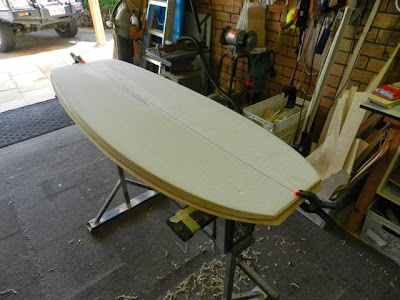EPS blank with 3mm rail band on and profiled by the AKU machine
Cutting out the 4mm deck skin and 3mm bottom skin
Polyurethane glue comes out of the bottle looking like honey , but as it takes in the moisture from the air it goes a more creamy look as the reaction takes place
It is spread thinly as it expands quite a lot
Fresh out of the vacuum bag ready to laminate the rails on
Rails on , nose and tail block on, excess timber removed and ready to shape the rails and give it some shape.The 15kg weight is great for holding the board in place and get stuck into the planing
The lights in the shaping bay help by casting shadows that show the flow of the curves.
Once I have taken the bulk off with the plane and faired it out I use a wide strip of emery cloth to blend the curves. This has been a great find. The fabric backing is tough and flexible allowing you to get some weight behind it with out tearing like sand paper. It comes in a good range of grits and I just use 1/2 a sheet. The grit is strong and won't clog up and seems to last for a long time as it was designed to be used on metal.
Final sanded to 240 grit all over, ready for logo's
First coats of lanolin oil soaking in in the sun.
Soaking it up



























